Employer-sponsored insurance covers over half of the non-elderly population; approximately 150 million nonelderly people in total. To provide current information about employer-sponsored health benefits, the Kaiser Family Foundation (Kaiser) and the Health Research & Educational Trust (HRET) conduct an annual survey of private and nonfederal public employers with three or more workers. This is the eighteenth Kaiser/HRET survey and reflects employer-sponsored health benefits in 2016.
HEALTH INSURANCE PREMIUMS AND WORKER CONTRIBUTIONS
In 2016, the average annual premiums for employer-sponsored health insurance are $6,435 for single coverage and $18,142 for family coverage. The average family premium rose 3% over the 2015 average premium while the increase in the premium for single coverage was not statistically significant. The average premium for family coverage is lower for covered workers in small firms (3-199 workers) than for workers in large firms (200 or more workers) ($17,546 vs. $18,395). Workers’ wages increased 2.5% and inflation increased 1.1% over the period. Premiums for family coverage have increased 20% since 2011 and 58% since 2006. Average premiums for high-deductible health plans with a savings option (HDHP/SOs) are considerably lower than the overall average for all plan types for both single and family coverage, at $5,762 and $16,737 respectively (Exhibit A). These premiums do not include any employer contributions to workers’ health savings accounts or health reimbursement arrangements. As discussed below, the share of covered workers with HDHP/SOs has grown eight percentage points over the last two years; this change in enrollment has reduced the growth in single and family premiums by roughly a half percentage point each of the last two years.
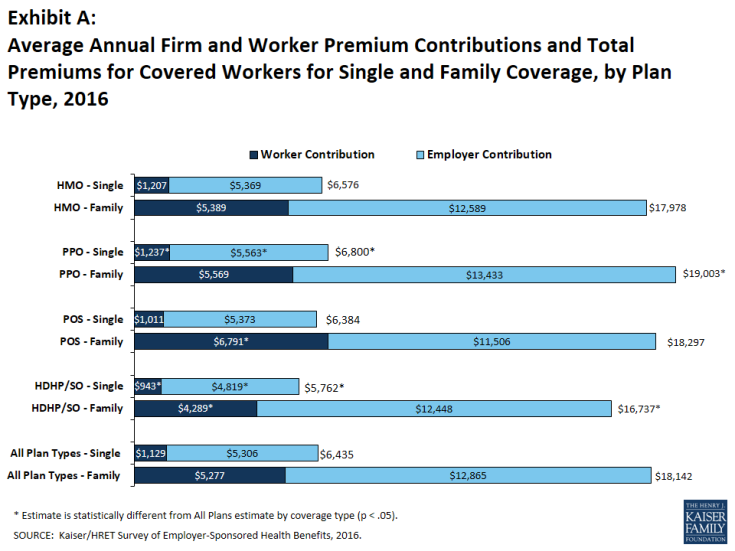
Exhibit A: Average Annual Firm and Worker Premium Contributions and Total Premiums for Covered Workers for Single and Family Coverage, by Plan Type, 2016
Premiums vary significantly around the averages for both single and family coverage, reflecting differences in health care costs and compensation decisions across regions and industries. Seventeen percent of covered workers are in plans with an annual total premium for family coverage of at least $21,771 (120% or more of the average family premium), and 19% of covered workers are in plans where the family premium is less than $14,514 (less than 80% of the average family premium) (Exhibit B).
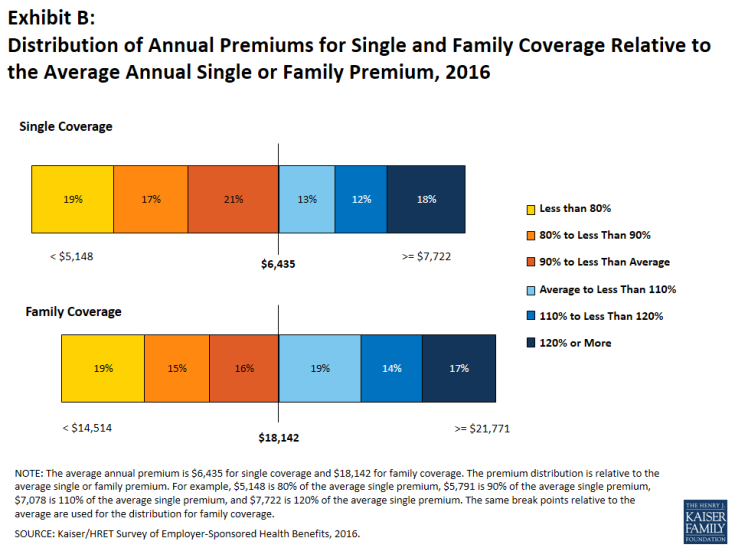
Exhibit B: Distribution of Annual Premiums for Single and Family Coverage Relative to the Average Annual Single or Family Premium, 2016
Most covered workers make a contribution towards the cost of the premium for their coverage. On average, covered workers contribute 18% of the premium for single coverage and 30% of the premium for family coverage, similar percentages to the recent past. Workers in small firms contribute a higher average percentage of the premium for family coverage (39% vs. 26%) than workers in large firms. Covered workers in firms with a relatively high percentage of lower-wage workers (at least 35% of workers earn $23,000 a year or less) contribute higher percentages of the premium for single (23% vs. 18%) and family (35% vs. 30%) coverage than workers in firms with a smaller share of lower-wage workers. As with total premiums, the share of the premium contributed by workers varies considerably. For single coverage, 12% of covered workers are in plans that do not require them to make a contribution, 62% are in plans which require a contribution of 25% or less of the total premium, and 2% are in plans that require a contribution of more than half of the premium. For family coverage, 3% of covered workers are in plans that do not require them to make a contribution, 45% are in a plan that requires a contribution of 25% or less of the total premium, and 15% are in plans that require more than half of the premium (Exhibit C). Covered workers in small firms are much more likely to be in a plan that requires the worker to contribute more than 50% of the total family premium than covered workers in larger firms (34% vs. 7%).
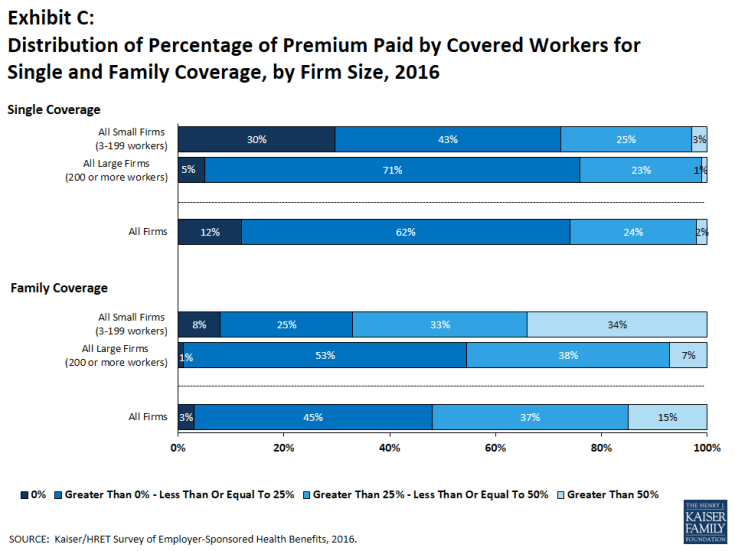
Exhibit C: Distribution of Percentage of Premium Paid by Covered Workers for Single and Family Coverage, by Firm Size, 2016
One reason for this variation is the different approaches that employers use to structure employee contributions, particularly for family coverage. Of firms that offer family coverage: 45% of small firms and 18% of large firms provide the same dollar contribution for single and family coverage, which means that employees must pay the full additional premium cost to enroll family members in their plan; 45% of small firms and 67% of large firms make a higher dollar contribution for family coverage than for single coverage, 3% of small firms and 6% of large firms vary their approach with the class of the employee; and the remaining 7% of small firms and 9% of large firms take some other approach. Fifteen percent of firms that offer health benefits require workers who use tobacco to contribute more towards the premium than those who do not use tobacco. Looking at the dollar amounts that workers contribute, the average annual premium contributions for 2016 are $1,129 for single coverage and $5,277 for family coverage. Covered workers’ average dollar contribution to family coverage has increased 78% since 2006 (Exhibit D) and 28% since 2011 (data not shown). Covered workers in small firms have lower average contributions for single coverage than workers in large firms ($1,021 vs. $1,176), but higher average contributions for family coverage ($6,597 vs. $4,719). Average contribution amounts for covered workers in HDHP/SOs are lower for single and family coverage than for covered workers in other plan types (Exhibit A).
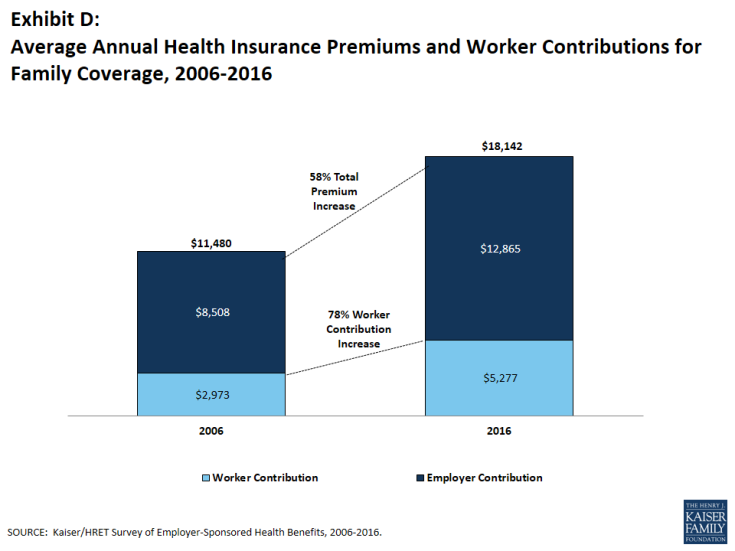
Exhibit D: Average Annual Health Insurance Premiums and Worker Contributions for Family Coverage, 2006-2016
PLAN ENROLLMENT
PPOs continue to be the most common plan type in 2016, enrolling 48% of covered workers. Twenty-nine percent of covered workers are enrolled in a high-deductible plan with a savings option (HDHP/SO), 15% in an HMO, 9% in a POS plan, and less than 1% in a conventional (also known as an indemnity) plan. Over the last two years, enrollment in PPOs has fallen 10 percentage points while enrollment in HDHP/SOs has increased 8 percentage points (Exhibit E).
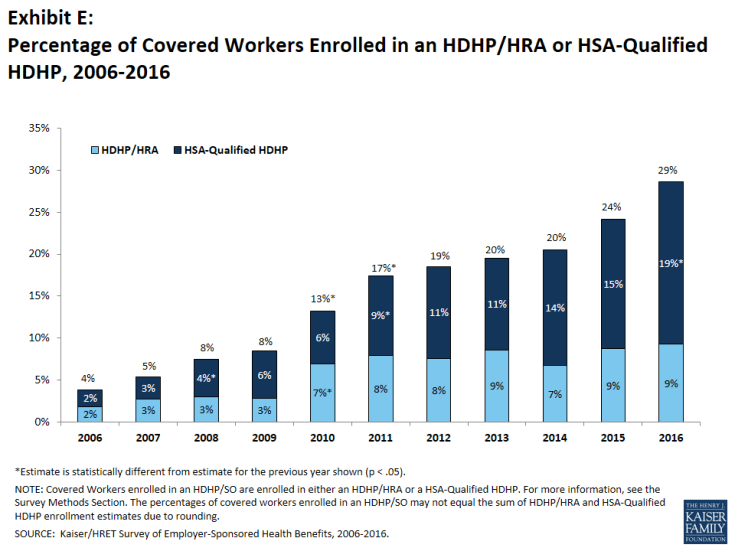
Exhibit E: Percentage of Covered Workers Enrolled in an HDHP/HRA or HSA-Qualified HDHP, 2006-2016
Plan enrollment differs with firm size: 52% of covered workers in large firms are enrolled in PPOs, compared to 39% percent in small firms; 18% percent of covered workers in small firms are enrolled in POS plans, compared to 4% in large firms.
EMPLOYEE COST SHARING
Most covered workers must pay a share of the cost when they use health care services. Eighty-three percent of covered workers have a general annual deductible for single coverage that must be met before most services are paid for by the plan. Even workers without a general annual deductible often face other types of cost sharing when they use services, such as copayments or coinsurance for office visits and hospitalizations. Among covered workers with a general annual deductible, the average deductible amount for single coverage is $1,478, higher than the average deductible last year ($1,318). Among all covered workers, those enrolled at firms with a deductible and those without, the average deductible is $1,221, significantly more than $1,077 in 2015. The average deductible for covered workers is higher in small firms than in large firms ($2,069 vs. $1,238). Sixty-five percent of covered workers in small firms and 45% of covered workers in large firms are in a plan with a deductible of at least $1,000 for single coverage, similar to the percentages last year (Exhibit F); a similar pattern exists for those in plans with a deductible of at least $2,000 (41% for small firms vs. 16% for large firms).
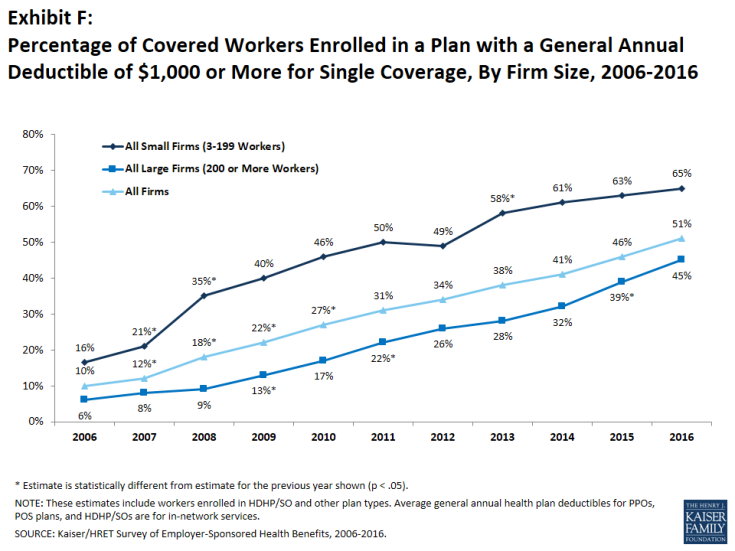
Exhibit F: Percentage of Covered Workers Enrolled in a Plan with a General Annual Deductible of $1,000 or More for Single Coverage, By Firm Size, 2006-2016
Deductibles have increased in recent years due to higher deductible amounts within plan types (particularly PPO plans) and to higher enrollment in HDHP/SOs. While growing deductibles in PPOs and other plan types generally increases enrollee out-of-pocket liability, the shift in enrollment to HDHP/SOs does not necessarily do so because most HDHP/SO enrollees receive an account contribution from their employers, which in essence reduces the high cost sharing in these plans. Fourteen percent of covered workers in an HDHP with a Health Reimbursement Arrangement (HRA) and 7% of covered workers in a Health Savings Account (HSA)-qualified HDHP receive an account contribution for single coverage at least equal to their deductible, while another 47% of covered workers in an HDHP with an HRA and 28% of covered workers in an HSA-qualified HDHP receive account contributions that, if applied to their deductible, would reduce their deductible to less than $1,000. If we reduce the deductibles that workers face by employer account contributions, the percentage of covered workers with a deductible liability of $1,000 or more would be reduced from 51% to 38% (Exhibit G).
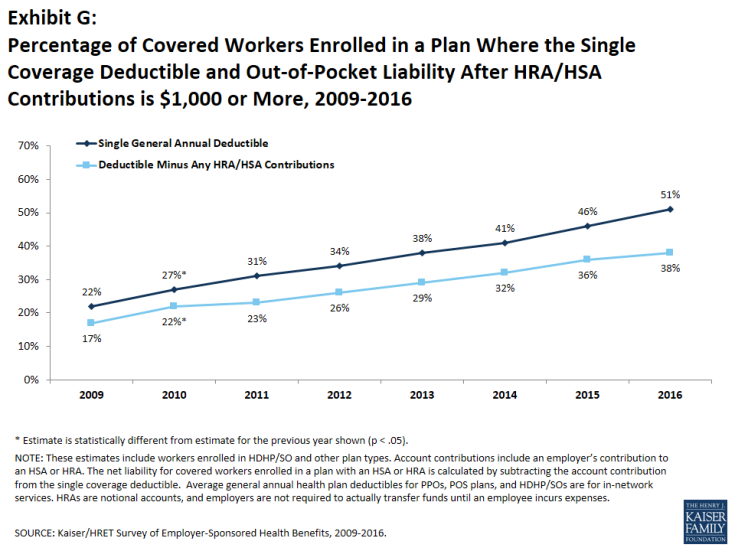
Exhibit G: Percentage of Covered Workers Enrolled in a Plan Where the Single Coverage Deductible and Out-of-Pocket Liability After HRA/HSA Contributions is $1,000 or More, 2009-2016
Whether they face a general annual deductible or not, a large share of covered workers also pay a portion of the cost when they visit a physician. For primary care, 67% of covered workers face a copayment (a fixed dollar amount) when they visit a doctor and 25% face coinsurance (a percentage of the covered amount). For specialty care, 66% face a copayment and 26% face coinsurance. The average in-network copayments are $24 for primary care and $38 for specialty care. The average in-network coinsurance is 18% for primary and 19% for specialty care. These amounts are similar to those in 2015. Most workers also face additional cost sharing for a hospital admission or an outpatient surgery episode. After any general annual deductible is met, 64% of covered workers have a coinsurance and 14% have a copayment for hospital admissions. Lower percentages have per day (per diem) payments (6%), a separate hospital deductible (1%), or both copayments and coinsurance (10%). The average coinsurance rate for hospital admissions is 19%. The average copayment is $282 per hospital admission, the average per diem charge is $281, and the average separate annual hospital deductible is $898. The cost sharing provisions for outpatient surgery follow a similar pattern to those for hospital admissions; most covered workers have either coinsurance (66%) or copayments (17%). For covered workers with cost sharing for outpatient surgery, the average coinsurance rate is 19% and the average copayment is $170. While almost all (98%) covered workers are in plans with a limit on in-network cost sharing (called an “out-of-pocket maximum”) for single coverage, there is considerable variation in the actual dollar limits. Fourteen percent of these workers are in a plan with an annual out-of-pocket maximum for single coverage of less than $2,000 while 18% are in a plan with an out-of-pocket maximum of $6,000 or more.
AVAILABILITY OF EMPLOYER-SPONSORED COVERAGE
Fifty-six percent of firms offer health benefits to at least some of their workers, similar overall to percentages in recent years (Exhibit H). The percentages of smaller firms (10 to 49 workers) offering coverage, however, has fallen since 2011 and years before. This trend precedes the ACA coverage expansions and is consistent with longer-term trends reported
elsewhere.
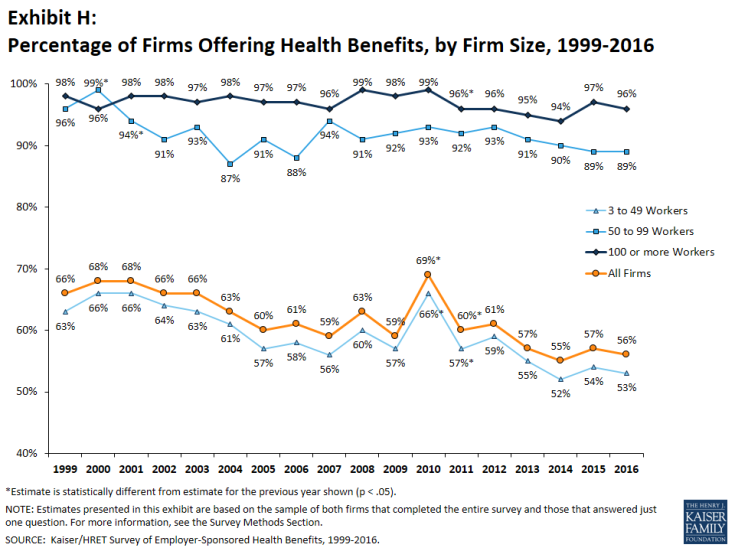
Exhibit H: Percentage of Firms Offering Health Benefits, by Firm Size, 1999-2016
The likelihood of offering health benefits differs significantly by firm size, with only 46% of employers with 3 to 9 workers offering coverage while virtually all employers with 1,000 or more workers offer coverage. Eighty-nine percent of workers are in a firm that offers health benefits to at least some of its employees, similar to recent years. Even when firms do offer health benefits, not all of their workers are covered there. Some workers are not eligible to enroll (e.g., waiting periods or part-time or temporary work status) and others who are eligible choose not to enroll (e.g., they feel the coverage is too expensive or they are covered through another source). In firms that offer coverage, an average of 79% of workers are eligible for the health benefits offered by the firm, and of those eligible, 79% take up the firm’s offer, resulting in 62% of workers in offering firms having coverage through their employer. If we look across workers both in firms that offer and those that do not offer health benefits, 55% of workers are covered by health plans offered by their employer. All of these percentages are similar to 2015. Over the longer term, however, the percentage of workers in all firms covered by a health plan from their employer has fallen from 59% in 2006 and 58% in 2011 to 55% in 2016 (Exhibit I).
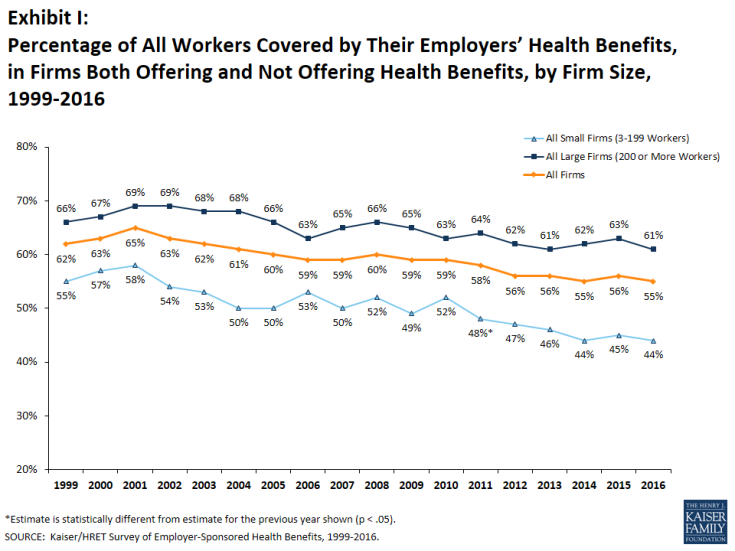
Exhibit I: Percentage of All Workers Covered by Their Employers’ Health Benefits, in Firms Both Offering and Not Offering Health Benefits, by Firm Size, 1999-2016
The Affordable Care Act (ACA) provision requiring employers with at least 50 full-time equivalent employees (FTEs) to offer health benefits that meet minimum standards for value and affordability to their full-time workers or pay a penalty took full effect in 2016. Ninety-seven percent of firms with at least 50 FTEs reported that they offer coverage to at least 95% of their employees who work on average 30 hours per week or more, and 96% responded that they offer at least one plan that met the ACA standards for affordability and minimum value. These firms were also asked about changes they planned to make or had made in the past year in response to the employer responsibility requirement. Two percent said they changed or planned to change the job classifications of some employees from full-time to part-time so that they would not be eligible for health benefits, while 7% said they changed or planned to change job classifications of some employees from part-time to full-time so that they would become eligible for health benefits. Other actions included 4% reducing or planning to reduce the number of full-time employees that they intended to hire because of the cost of providing health benefits to them, 2% increasing or planning to increase the waiting period before new employees become eligible for benefits, 12% extending or planning to extend eligibility for health benefits to workers who were not previously eligible, and 2% extending or planning to extend eligibility for more comprehensive benefits to employees previously eligible only for limited benefit plans.
Coverage for Spouses and Unmarried Partners. Virtually all firms offering health benefits offer coverage for spouses, although 13% of small firms and 5% of large firms say that spouses are ineligible to enroll if a spouse is offered coverage from another source, and an additional 5% of small firms and 8% of large firms say that spouses offered coverage from other sources can enroll only under certain conditions. Twelve percent of firms offering coverage to spouses have a higher contribution or cost sharing for spouses who are eligible for coverage from another source, while 10% of firms offering coverage give additional compensation to employees who choose to enroll in their spouse’s plan. Two percent of firms offering coverage to spouses report that they made a significant reduction in the amount that they contributed for covering employees’ spouses during the last year. All of these percentages are similar for small and large firms. Among firms offering family coverage, 32% offer coverage to same-sex unmarried partners, with an additional 33% saying they do not know or have not encountered the situation. Large firms are more likely to offer coverage to same-sex unmarried partners than small firms (49% vs. 32%); small firms are much more likely to say they do not know or have not encountered the situation (34% vs. 5%). Twenty-seven percent of firms offering family coverage offer to unmarried opposite-sex partners, with an additional 28% saying that do know or have not encountered the situation. Large firms are more likely to offer coverage to unmarried opposite-sex partners than smaller firms (42% vs. 26%); small firms are more likely to report they do not know or have not encountered the situation (28% vs. 2%).
RETIREE COVERAGE
Of the large firms offering health benefits in 2016, 24% also offer health benefits to retirees, similar to the percentage in 2015 (23%). Among large firms that offer retiree health benefits, 92% offer health benefits to early retirees (workers retiring before age 65) and 72% offer health benefits to Medicare-age retirees. Six percent of large firms offering retiree benefits offer some retiree benefits through a corporate or private exchange, and 17% (down from 26% in 2015) report they are considering changing the way they offer retiree coverage because of the new health insurance exchanges established by the ACA.
WELLNESS, HEALTH RISK ASSESSMENTS AND BIOMETRIC SCREENINGS
Employers continue to show interest in programs that encourage employees to identify health issues and to take steps to improve their health (Exhibit J). A large share now offer health screening programs including health risk assessments, which are questionnaires asking employees about lifestyle, stress or physical health, and in-person examinations such as biometric screenings. Many employers have incentive programs that reward or penalize employees for completing assessments, participating in wellness programs, or meeting biometric outcomes. These survey questions on these topics were revised for 2016 and are asked only of firms offering health benefits. Because there was considerable uncertainty among small firms on some questions, particularly those related to incentives, findings are reported only for large firms in some instances.
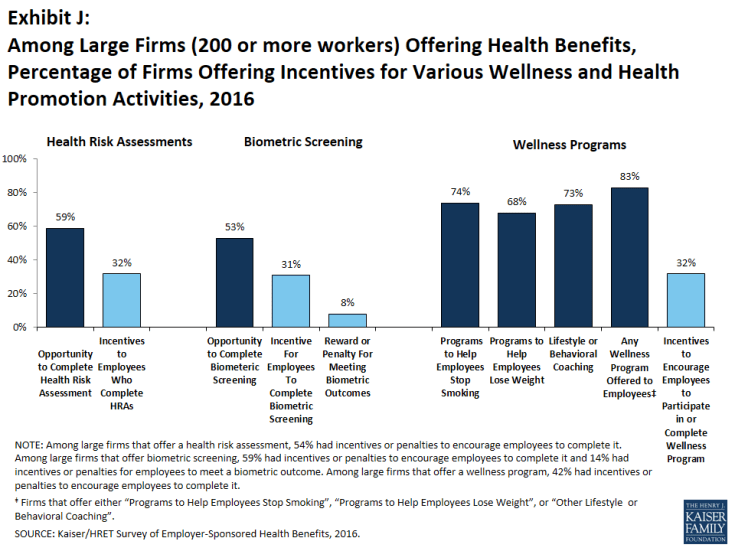
Exhibit J: Among Large Firms (200 or more workers) Offering Health Benefits, Percentage of Firms Offering Incentives for Various Wellness and Health Promotion Activities, 2016
Health Risk Assessments. Among firms offering health benefits, 32% of small firms and 59% of large firms provide employees with an opportunity to complete a health risk assessment. A health risk assessment includes questions about a person’s medical history, health status, and lifestyle. Fifty-four percent of large firms with a health risk assessment program offer a financial incentive to encourage employees to complete the assessment. Among large firms with an incentive, the incentives include: lower premium contributions or cost sharing (51% of firms); requiring a completed health risk assessment to be eligible for other wellness incentives (44% of firms); and cash, contributions to health-related savings accounts, or merchandise (60% of firms).
Biometric Screening. Twenty percent of small firms and 53% of large firms offering health benefits offer employees the opportunity to complete biometric screening. Biometric screening is a health examination that measures an employee’s risk factors such as body weight, cholesterol, blood pressure, stress, and nutrition. Fifty-nine percent of large firms with biometric screening programs offer employees an incentive to complete the screening. Among large firms with an incentive, the incentives include: lower premium contributions or cost sharing (52% of firms); requiring a completed biometric screening to be eligible for other wellness incentives (32% of firms); and cash, contributions to health-related savings accounts, or merchandise (56% of firms). In addition, 14% of large employers with biometric screening programs have financial incentives tied to whether or not employees met or were able to meet specified biometric outcomes, such as a targeted body mass index (BMI) or cholesterol level.
Health and Wellness Promotion Programs. Many employers offer wellness or health promotion programs to help employees improve their health and avoid unhealthy behaviors. Forty-six percent of small firms and 83% of large firms offer a program in at least one of these areas: smoking cessation; weight management; behavioral or lifestyle coaching. Three percent of small firms and 16% of large firms report collecting health information from employees through wearable devices such as a Fitbit or Apple Watch. Forty-two percent of large firms with one of these health and wellness programs offer employees a financial incentive to participate in or complete the program. Among large firms with an incentive for completing wellness programs, incentives include: lower premium contributions or cost sharing (34% of firms); cash, contributions to health-related savings accounts, or merchandise (76% of firms); some other type of incentive (14% of firms). Some firms separate financial incentives for different programs and some others have incentives that require participation in more than one type of program (e.g., completing an assessment and participating in a health promotion activity). We asked firms that had any incentives for health risk assessments, biometric screening or the specified health and wellness promotion programs what the maximum financial incentive was for a worker for all of their programs combined. Among large firms with any type of incentive, 26% have a maximum financial incentive of less than $150, 35% have a maximum incentive between $150 and $500, 23% have a maximum incentive between $500 and $1,000, 9% have a maximum incentive between $1,000 and $2,000, and 7% have a maximum incentive of $2000 or more.
Sites of Care
Telemedicine. Thirty-nine percent of large firms that offer health benefits cover the provision of some health care services through telecommunication in their largest health plan. We revised our questions for 2016 to clarify that we were asking about payment for services and not just the electronic exchange of information. Among these firms, 33% reported that workers have a financial incentive to receive services through telemedicine as instead of visiting a physician’s office.
Retail Health Clinics. Sixty percent of small firms and 73% of large firms cover services offering health benefits provided in retail health clinics, such as those found in pharmacies and supermarkets, in their largest health plan. Among large firms covering services in retail clinics, 10% reported that workers had a financial incentive to receive services in a retail clinic instead of visiting a traditional physician’s office.
On-Site Health Clinics. Among firms with at least 50 employees offering health benefits, five percent provide health services to employees through an on-site health clinic in at least one of their major locations. Eighty-six percent of these firms provided some services for non-work-related illnesses through the on-site clinic. Firms with at least 1,000 workers were more likely to have an on-site health clinic than smaller firms (25% vs. 4%).
PROVIDER NETWORKS
High Performance or Tiered Networks. Fourteen percent of large firms offering health benefits have high performance or tiered networks in their largest health plan, down from 24% last year. These programs identify providers that are more efficient or have higher quality care, and may provide financial or other incentives for enrollees to use the selected providers.
Narrow Networks. Seven percent of firms offering health benefits offer a health plan that they consider to have a narrow network (i.e., a network they would consider more restrictive than a standard HMO network), similar to the percentage reported last year. There is no difference between small and large firms on this measure. Six percent of firms reported that they or their insurer had eliminated a hospital or health system from any of their plans’ networks in order or reduce costs. There is no difference between small and large firms on this measure.
OTHER TOPICS
Self-Funding. Thirteen percent of covered workers in small firms and 82% in large firms are enrolled in plans that are either partially or completely self-funded, similar to last year. Overall, 61% of covered workers are enrolled in a plan that is either partially or completely self-funded.
Private Exchanges. Four percent of firms offering health benefits with at least 50 employees offer health benefits through a private exchange. Private exchanges are arrangements, usually created by consultants, brokers or insurers, which allow employers to offer their employees a choice of different benefit options, often from different insurers. Among firms offering health benefits that do not currently offer through a private exchange, 18% with at least 50 workers, including 28% with at least 5,000 workers, say they have considered offering coverage through a private exchange.
Professional Employment Organization. Some firms provide for health and other benefits by entering into a co-employment relationship with a Professional Employer Organization (PEO). Under this arrangement, the firm manages the day-to-day responsibilities of employees, but the PEO hires the employees and acts as the employer for insurance, benefits, and other administrative purposes. Four percent of small firms offering health benefits offer coverage through a PEO, similar to last year.
Grandfathered Health Plans. The ACA exempts “grandfathered” health plans from a number of its provisions, such as the requirement to cover preventive benefits without cost sharing or the new rules for small employers’ premiums ratings and benefits. An employer-sponsored health plan can be grandfathered if it covered a worker when the ACA became law (March 23, 2010) and if the plan has not made significant changes that reduce benefits or increase employee costs. Twenty-three percent of firms offering health benefits offer at least one grandfathered health plan in 2016, down from 35% last year. Twenty-three percent of covered workers are enrolled in a grandfathered health plan, similar to the percentage in 2015.
EXCISE TAX ON HIGH-COST HEALTH PLANS
Under the ACA, employer health plans in 2020 will be subject to an excise tax of 40% on the amount by which their cost exceeds specified thresholds. The tax was scheduled to take effect in 2018, but its effective date was delayed two years. The tax is calculated with respect to each employee based on the combination of health benefits received by that employee, including the employer and employee share of health plan premiums and account contributions. Of firms offering health benefits, 15% of small firms and 64% of large firms say they have conducted an analysis to determine if they will exceed the thresholds, with 29% of the small firms and 27% of the large firms saying that their largest health plan would exceed the threshold in 2020. Some plans report planning or taking action in the last year in anticipation of the assessment: four percent of small firms and 15% of large firms increased cost sharing; three percent of small firms and nine percent of large firms switched to a lower cost plan or eliminated a plan option; three percent of small firms and eight percent of large firms moved benefit options to an account-based plan; and four percent of small firms and two percent of large firms selected a plan with a smaller network of providers.
CONCLUSION
This is the fifth straight year of relatively low premium growth (family coverage growing between 3 and 4 percentage points each year), but the stability for premiums belies some other changes that have occurred during the period. Deductibles continued to grow in 2016; over the last five years, the percentage of covered workers facing a general annual deductible has grown from 74% to 83%, while the average single deductible amount (among those facing a deductible) increased from $991 to $1,478. These higher deductibles likely contributed to the moderating premium increases over this period. The higher deductibles have resulted, in part, by growing enrollment in HDHP/SOs, where enrollment has gone from 17% of covered workers in 2011 to 29% in 2016. Just in the last two years, enrollment in HDHP/SOs has grown by eight percentage points while PPO enrollment has declined by ten. More enrollment in HDHP/SOs has several implications for costs: they have higher deductibles than other plan types, but many enrollees also receive contributions to their HSA or HRAs that offset some or all of the cost sharing; they have lower total premiums and worker contribution amounts, although contributions by employers toward enrollee HRAs and HSAs offset some of the impact of the lower premiums for employers. There has been a reduction in offering for firms with 10 to 49 workers over the period, decreasing from 74% in 2011 (and 76% in 2012) to 66% in 2016. This change precedes the introduction of public marketplaces and premium tax credits, and other sources show a longer term reduction in offer rates among small private firms. Across all workers (both in firms that offer and do not offer coverage) during the period, the percentage of workers with coverage from their own employer has fallen from 58% in 2011 to 55% in 2016. Employers, particularly larger ones who employ most workers, continue to show interest in programs to improve health and in new delivery options. Significant shares of small and large employers offer employees the opportunity to complete health risk assessments or biometric screening or to participate in lifestyle coaching or other health promotion programs; many large employers provide employees with financial incentives to complete assessments or participate in programs. Employers also are covering services through new venues, such as retail health clinics and telemedicine, sometimes providing financial incentives for employees to use these new options. Finally, the continuing implementation of the ACA does not appear to be causing major disruptions in employer market. The employer responsibility provision was fully implemented in 2016, with virtually all employers with 50 or more FTEs saying that they offer coverage to full-time employees that meets affordability and minimum value standards. Relatively few employers made changes to working hours or hiring as a result of the provision, with more taking actions that increased coverage offers than reducing them, similar to the results last year. Most large employers, but few small employers, have analyzed how the high cost plan tax will affect them when it takes effect in 2020, with about 12% of offering firms saying they have taken some action in response to the tax. Looking forward, there are several emerging issues to watch. One is growth of HDHO/SOs, which after a lull, have seen significant enrollment growth in the last two years. These plans have relatively high cost sharing, but as discussed above, some workers receive significant account contributions to offset some of these costs. Another issue is whether the share of smaller firms offering coverage continues to fall. These firms are not required to offer coverage under the ACA, and in some cases, their workers might have more affordable options in public marketplaces than through work, which could encourage employers to stop offering. And, while the high-cost plan excise tax has been delayed until 2020, a meaningful share of employers estimates that they will be subject to the assessment. Only small shares of firms have reacted so far, but this may accelerate over the next couple of years if the 2020 date remains in place.
METHODOLOGY
The Kaiser Family Foundation/Health Research & Educational Trust 2016 Annual Employer Health Benefits Survey (Kaiser/HRET) reports findings from a telephone survey of 1,933 randomly selected public and private employers with three or more workers. Researchers at the Health Research & Educational Trust, NORC at the University of Chicago, and the Kaiser Family Foundation designed and analyzed the survey. National Research, LLC conducted the fieldwork between January and June 2016. In 2016, the overall response rate is 40%, which includes firms that offer and do not offer health benefits. Among firms that offer health benefits, the survey’s response rate is also 40%. We asked all firms with which we made phone contact, even if the firm declined to participate in the survey: “Does your company offer a health insurance program as a benefit to any of your employees?” A total of 3,110 firms responded to this question (including the 1,933 who responded to the full survey and 1,177 who responded to this one question). Their responses are included in our estimates of the percentage of firms offering health benefits. The response rate for this question is 65%. Since firms are selected randomly, it is possible to extrapolate from the sample to national, regional, industry, and firm size estimates using statistical weights. In calculating weights, we first determine the basic weight, then apply a nonresponse adjustment, and finally apply a post-stratification adjustment. We use the U.S. Census Bureau’s Statistics of U.S. Businesses as the basis for the stratification and the post-stratification adjustment for firms in the private sector, and we use the Census of Governments as the basis for post-stratification for firms in the public sector. Some numbers in the report’s exhibits do not sum up to totals because of rounding effects, and, in a few cases, numbers from distribution exhibits referenced in the text may not add due to rounding effects. Unless otherwise noted, differences referred to in the text and exhibits use the 0.05 confidence level as the threshold for significance. For more information on the survey methodology, please visit the Methodology section at
http://ehbs.kff.org/.
The Kaiser Family Foundation, a leader in health policy analysis, health journalism and communication, is dedicated to filling the need for trusted, independent information on the major health issues facing our nation and its people. The Foundation is a non-profit private operating foundation based in Menlo Park, California.
The Health Research & Educational Trust (HRET) Founded in 1944, the Health Research & Educational Trust (HRET) is the not-for-profit research and education affiliate of the American Hospital Association (AHA). HRET’s mission is to transform health care through research and education. HRET’s applied research seeks to create new knowledge, tools and assistance in improving the delivery of health care by providers and practitioners within the communities they serve.










